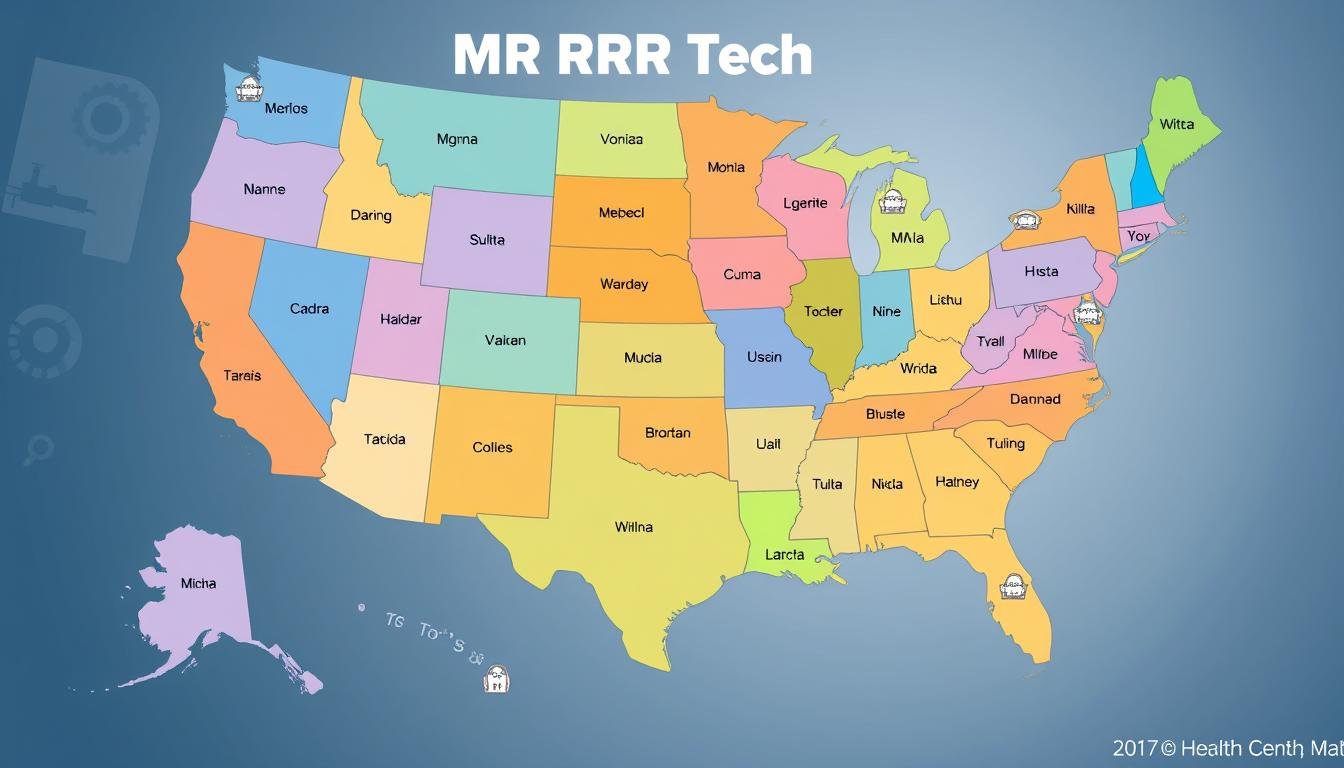MRI technologists are vital in the healthcare industry. They provide key diagnostic services using advanced imaging equipment.
The field offers excellent pay and career growth. Let’s explore the average MRI tech salary in the US.
This is a detailed illustration of an MRI technologist in a modern hospital setting showcasing advanced MRI machines and equipment. The focus is on the technologist’s professional attire and expertise, surrounded by visual representations of salary trends, charts, and financial symbols subtly integrated into the background.
MRI techs create detailed images of the human body. Doctors use these images to diagnose and track many health issues.
Their skills are in high demand across healthcare. This makes it a rewarding and well-paying career choice.
Understanding MRI Technologist Roles
MRI technologists operate diagnostic imaging machines. They are vital members of healthcare teams.
These experts run and maintain MRI equipment. They ensure machines work well to capture high-quality images.
MRI technologists interact with patients, too. They explain procedures and address concerns to ensure comfort.
Building trust is key to better outcomes. Their patient-centered approach helps achieve this goal.
Becoming an MRI technologist requires specific education—most complete accredited programs for associate’s or bachelor’s degrees.
Certification from ARRT or similar bodies is also needed. This proves their skills in diagnostic imaging.
MRI technologists have diverse skills and specialized knowledge. They expertly use advanced equipment and provide personalized care.
Their work aids in accurate diagnosis. This contributes to the effective treatment of many medical conditions.
Average MRI Tech Salary in the United States
MRI techs in the US have impressive earning potential. In 2021, the median salary was $74,660 per year.
Top-earning MRI techs make over $99,000 annually. Experience greatly influences salaries in this field.
Entry-level positions start around $55,000. Seasoned pros can earn upwards of $85,000.
Urban areas and specialized facilities often offer higher wages. This is compared to smaller or rural healthcare settings.
MRI techs earn more than X-ray and CT scan technicians. This reflects their advanced training and skills.
The job outlook for MRI technologists is bright. Demand for medical imaging continues to grow.
Factors Affecting MRI Tech Salaries
Education and training levels impact MRI tech pay. Advanced certifications often lead to higher salaries.
Experience is key in determining MRI tech wages. Seasoned pros usually earn more than newcomers.
Workplace settings influence MRI technologist pay. Hospitals and large healthcare systems often offer better compensation.
Salaries vary based on location. Different regions have different pay scales for MRI techs.
Specialized skills can boost earning potential. Expertise in pediatric or cardiac imaging is valuable.
Advanced equipment skills may lead to higher wages. Proficiency in complex MRI machines is highly sought after.
MRI Tech Salary by State
MRI tech pay varies across the United States. Factors like living costs and healthcare demand affect salaries.
California, Massachusetts, and New York offer higher salaries. Mississippi, Arkansas, and Oklahoma tend to pay less.
Urban areas often pay more than rural regions. This applies even within the same state.
A colorful map of the United States highlighting different states, each filled with varying shades representing MRI tech salaries, with icons of MRI machines scattered across the map and a gradient background illustrating a health care theme.
Knowing salary trends helps MRI techs boost their earnings. Research can guide career choices and highlight the best markets.
Job Outlook for MRI Technologists
MRI technologists have bright career prospects. The US Bureau of Labor Statistics predicts a 7% job growth from 2019 to 2029.
This growth is due to the increased use of MRI technology. The aging population also requires more medical services.
Medical facilities are investing in advanced imaging equipment. This creates more demand for skilled MRI technologists.
New MRI techniques are being developed. MRI usage is expanding into new areas of healthcare.
The future looks promising for MRI technologists. Staying current with new developments is key to success.
Continuous skill development is essential. This career path is dynamic and rewarding.
Additional Benefits for MRI Techs
MRI technologists enjoy many perks beyond their good pay. These include health insurance, retirement plans, and lots of time off.
Healthcare facilities offer significant benefits to keeping skilled MRI technologists. They often provide health, dental, and vision insurance.
Many employers offer 401(k) plans with matching contributions. MRI techs are also paid for sick leave, vacation days, and holidays.
Continuing education is another perk for MRI technologists. Many employers pay for professional development courses.
This helps techs learn about new imaging tech and best practices. It also boosts their career chances.
The great benefits and good pay make this job very rewarding. It’s an attractive choice for a healthcare career.
Comparison with Other Imaging Technologists
MRI technologists earn competitive salaries in the medical imaging field. Their pay depends on education, experience, and work location.
X-ray technicians typically earn less than MRI techs. Their average salaries range from $55,000 to $65,000 yearly.
CT technologists can earn similar or higher salaries than MRI techs. Their pay often falls between $60,000 and $75,000.
Ultrasound technologists’ wages are often comparable to MRI techs. They typically earn between $60,000 and $80,000 per year.
Job duties, certifications, and expertise affect pay for imaging technologist roles. Understanding these factors helps professionals make informed career decisions.
Preparing for a Career as an MRI Tech
MRI tech hopefuls can start their journey by exploring various education options. Accredited programs offer training in magnetic resonance imaging theory and hands-on experience.
These programs cover how to use MRI equipment and provide top-notch patient care. The American Registry of Magnetic Resonance Imaging Technologists (ARMRIT) offers such programs.
Getting certified can boost career chances for MRI techs. The American Registry of Radiologic Technologists (ARRT) offers a respected credential.
ARRT certification shows a tech’s expertise and dedication to growth. This can lead to better job opportunities.
MRI techs can specialize in areas like cardiac imaging or neuroradiology. These niche fields often pay more and offer room for growth.
Staying up-to-date with industry trends is key to success. Continuous learning can lead to higher earning potential for MRI techs.
FAQ
What are the typical job duties of an MRI technologist?
MRI technologists operate special equipment to capture detailed body images. They position patients, select imaging protocols, and ensure equipment works properly.
Patient safety is a top priority for MRI technologists. They monitor patients throughout the imaging process.
What are the educational requirements for becoming an MRI technologist?
Most MRI tech jobs require an associate’s degree in radiologic technology. However, many employers prefer candidates with specialized MRI certification, such as the ARRT credential.
What is the average salary for an MRI technologist in the United States?
The median yearly salary for MRI technologists is about $73,720. Top earners can make over $94,000 per year.
What factors influence MRI technologist salaries?
Education, experience, and certifications can impact MRI tech pay. Location and workplace type also affect salaries.
Which states have the highest average salaries for MRI technologists?
California, Massachusetts, Washington, Alaska, and Hawaii pay MRI techs well. Salaries in these states can be 10-20% above average.
What is the job outlook for MRI technologists?
MRI tech jobs are growing fast. Employment is expected to increase by 7% from 2019 to 2029.
This growth comes from an aging population and more demand for imaging services.
What are some additional benefits for MRI technologists?
MRI techs often get health insurance and retirement plans. Many enjoy paid time off and tuition help.
There are also chances for professional growth and career advancement.
How do MRI technologists salaries compare to other imaging technologists?
MRI techs usually earn more than X-ray and ultrasound techs due to their special skills and knowledge.
What are some steps to prepare for a career as an MRI technologist?
Study radiologic technology or medical imaging at an accredited school. Gain the necessary certifications and experience in various imaging types.
This will boost your skills and earning potential as an MRI tech.
you may also read : Vet Tech Salary: How Much Can You Earn in 2024



